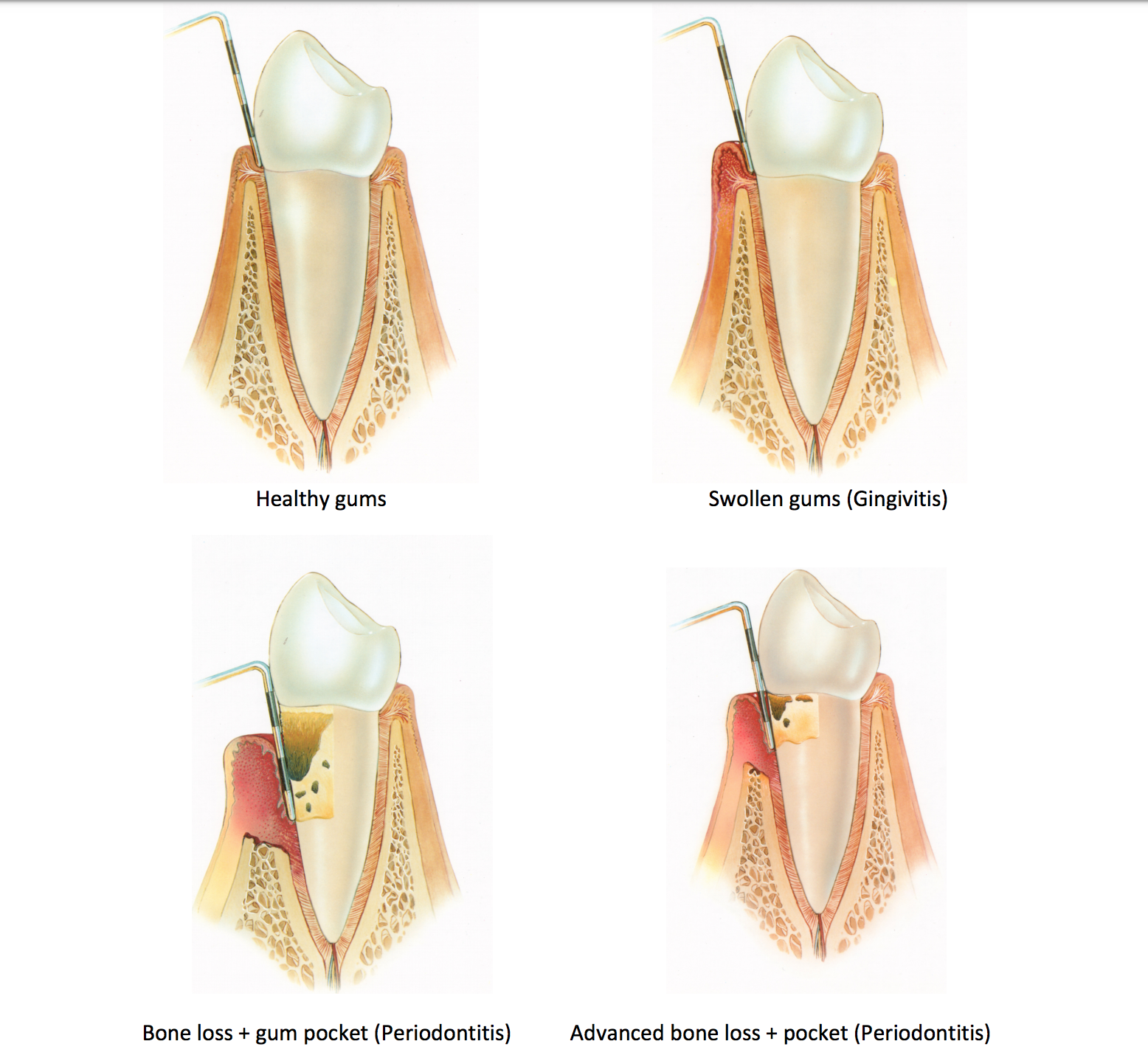Periodontal Treatment
What is a healthy periodontium?
In health, the roots of your teeth are embedded in the jaw bone. The gum overlies the bone and wraps around the teeth forming a collar around the neck of the teeth. The gum at the neck of the teeth is pale pink and firm.
What are periodontal (gum) diseases?
Periodontal diseases are infections that affect the gums and the underlying bone supporting the teeth. These infections are caused by bacteria. Bacteria are always present in the mouth and accumulate on the tooth surfaces after meals or drinks. They form a soft, sticky mass called “plaque”. Plaque is usually removed through regular tooth cleaning (brushing and cleaning between the teeth). However, if some plaque remains near the gum margin, inflammation of the gums may result (gingivitis). If not treated, this inflammation can progress to periodontal disease. Where periodontal disease occurs, the bacteria grow down below the gum margin along the root surface. The gums detach from the tooth and form so called “pockets”. As a result, the bone surrounding the teeth will retract away from the source of infection. With increasing bone destruction the tooth will loose its support. If left untreated it can lead to tooth loss. A gum pocket of 4mm or more if untreated is a risk for disease progression.
What is a Periodontist?
A periodontist is a dentist who specialises in the prevention, diagnosis, and treatment of periodontal disease, and in the placement & repair of dental implants. They receive a number of years of extensive training in these areas and are familiar with the latest treatment techniques along with performing cosmetic periodontal procedures.
Are there other factors contributing to periodontal (gum) disease?
Smoking is the most important risk factor for periodontal disease. Patients wit h periodontal disease who smoke tend to have higher numbers of deep gum pockets and loose more teeth than nonsmokers. Stress, uncontrolled diabetes and genetics factors may also play a role in periodontal disease. Also, increasing evidence supports an association between periodontal disease and other (systemic) diseases or complications, e.g. cardio-vascular diseases, pre-term low birth weight delivery. Treatment of periodontal disease could be beneficial in this respect.
How can you notice periodontal (gum) disease?
Periodontal disease can go on for years without pain and without detection unless specific examination procedures are performed. The patient can sometimes see that the gums are red, possibly swollen and bleed easily. Often, however, the patient may only notice minor discomfort and the condition may remain “silent” for many years. Too often, patients may notice the problem only when the bone loss around the teeth is so extensive that teeth become loose or when the gums start to recede. The disease is diagnosed by assessing the gum in several sites around each tooth together with detailed x-ray images.
Can it be treated successfully?
Although you cannot cure periodontitis, if diagnosed early enough or there is sufficient supporting bone left, disease can be prevented from progressing. However, to control the disease you would also have to carry out good daily oral hygiene in order to keep away harmful bacteria. In addition, particular risk factors (such as smoking) need to be controlled and you will need to see the dental hygienist in regular time intervals as recommended. Failure to do so will not guarantee maintaining a good result.
What does the treatment consist of?
The first phase of treatment normally consist of “deep” cleaning of the root surfaces below the gum level (subgingival root debridement). This is performed under local anaesthesia. This will reduce the level of inflammation and the depth of the pockets. Few weeks after, the response to the initial therapy will be assessed. Along with this, an extra appointment may be needed in education about the most effective way to brush around the teeth to control the amount of plaque bacteria around your gums.
For many patients deep cleaning will be sufficient to control the disease. However, in advanced cases of periodontal disease the “deep” cleaning alone may not be enough to control the disease. A second phase of therapy may include gum surgery to gain access to deep areas for cleaning. In some cases it is also possible to achieve new bone formation around the tooth (periodontal regeneration). Periodical tooth cleanings (every 2-4 months) should be carried out throughout the course of treatment as recommended. A final assessment will evaluate the result after the second phase of treatment. As soon as the condition is considered stable the patient will go back to the regular care by the dental hygienist (every 3-6 months) with periodic check-ups by the periodontist/general dental practitioner.
Are there adverse effects of the treatment?
Your gums may be sore for 2-3 days. The reduction of the depth of the pockets is likely to show in the form of some gum shrinkage (recession/root exposure) which can vary greatly in its extent. This is inevitable in cases where the gum was very swollen in the first place. In some patients this may cause increased tooth sensitivity. However, this is usually temporary and rarely lasts more than a few weeks/months. The periodontist will advise you on how to reduce tooth sensitivity.
Will I be able to retain my teeth for life?
If you have undergone a complete course of periodontal treatment and keep up with good oral hygiene and hygiene appointments you are likely to have a stable condition. If you fail to do so you are likely to have ongoing gum disease. All patients who have suffered from periodontal disease at some stage in their lives are at higher risk of experiencing an episode of gum disease again at a later stage. However, periodontal treatment followed by good home tooth cleaning and regular hygiene appointments will reduce this risk significantly.
